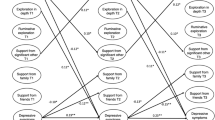Abstract
This investigation specified three models regarding the association between identity and intimacy formation and investigated their potential validity using a longitudinal cross-lag panel design. Seventy-one males and 71 females completed identity and intimacy measures on two occasions over a 5-week period. The primary findings are (1) individuals with a clear sense of identity are more likely, 5 weeks later, to have a more advanced sense of intimacy for both sexes when sex-role identification is removed from gender comparisons; (2) sex-role orientation mediates the identity/intimacy association, while for females, a masculine orientation is associated with a pattern similar to that observed for either masculine- or feminine-oriented males; and (3) femininity is associated with a more fused connection between identity and intimacy for females. This report provides an initial investigation studying the identity/intimacy association during late adolescence based on three theoretical perspectives. Theoretical interpretations and conclusions are offered.
Similar content being viewed by others
References
Adams, G. R., and Fitch, S. A. (1982). Ego stage and identity status development: A crosssequential analysis.J. Pers. Soc. Psychol. 42: 574–583.
Adams, G. R., and Fitch, S. A. (1983). Psychological environments of university departments: Effects on college students' identity status and ego development.J. Pers. Soc. Psychol. 44: 1266–1275.
Adams, G. R., and Gullotta, T. (1983).Adolescent Life Experiences, Brooks/Cole, Monterey, CA.
Appelbaum, M. I., and McCall, R. B. (1983). Design and analysis in developmental psychology. In Kessen, W. (ed.),Handbook of Child Psychology. Vol. 1: History, Theory and Methods, Wiley, New York.
Baucom, D. H., Besch, P. K., and Callahan, S. (1985). Relation between testosterone concentration, sex role identity, and personality among females.J. Pers. Soc. Psychol. 48: 1218–1226.
Bem, S. L. (1974). The measurement of psychological androgyny.J. Consult. Clin. Psychol. 42: 155–162.
Caslyn, R. J. (1976). Guidelines for using cross-lagged panel correlation.Represent. Res. Soc. Psychol. 7: 105–119.
Campbell, D., and Stanley, J. D. (1963).Experimental and Quasi-Experimental Designs for Research, Rand McNally, Chicago.
Chodorow, N. (1974). Family structure and feminine personality. In Rosaldo, M. Z., and Lamphere, L. (eds.),Woman, Culture and Society, Stanford University Press, Stanford, CA.
Constantinople, A. (1969). An Eriksonian measure of personality development in college students.Dev. Psychol. 1: 357–372.
Craig-Bray, L., Adams, G. R., and Dobson, W. R. (1988). Identity formation and social relations during late adolescence.J. Youth Adoles. 17: 173–187.
Douvan, E., and Adelson, J. (1966).The Adolescent Experience, Wiley, New York.
Dyk, P. A. H. (1987). Identity and intimacy: A correlational or causal connection? Unpublished master's thesis, Department of Family and Human Development, Utah State University, Logan, UT.
Erikson, E. H. (1959).Identity and the Life Cycle (Psychological Issues, No. 1), International Universities Press, New York.
Erikson, E. H. (1968).Identity: Youth and Crisis, Norton, New York.
Fischer, J. L. (1981). Transitions in relationship style from adolescence to young adulthood.J. Youth Adoles. 10: 11–24.
Fitch, S. A., and Adams, G. R. (1983). Ego-identity and intimacy status: Replication and extension.Dev. Psychol. 19: 839–845.
Freedman, B. (1986).Beauty Bound, D.C. Heath, Lexington, MA.
Gilbert, M. A., Bauman, K. E., and Udry, J. R. (1986). A panel study of subjective expected utility for adolescent sexual behavior.J. Appl. Soc. Psychol. 16: 745–756.
Gilligan, C. (1982).In a Different Voice, Harvard University Press, Cambridge, MA.
Gray, M. M., Ispa, J. M., and Thornburg, K. R. (1986). Erikson psychosocial stage inventory: A factor analysis.Educ. Psychol. Measur. 46: 979–983.
Hodgson, J. W., and Fischer, J. L. (1979). Sex differences in identity and intimacy development in college youth.J. Youth Adoles. 8: 37–50.
Josselson, R. (1987).Finding Herself: Pathways to Identity Development in Women, Jossey-Bass, San Francisco.
Kacerguis, M. A., and Adams, G. R. (1980). Erikson stage resolution: The relationship between identity and intimacy.J. Youth Adoles. 9: 117–126.
Kenny, D. A. (1975). Cross-lagged panel correlation: A test for spuriousness.Psychol. Bull. 82: 887–903.
Kenny, D. A. (1976).PANAL: A Computer Program for Panel Data Analysis, Department of Psychology, University of Connecticut, Storrs.
Kenny, D. A., and Harackiewicz, J. M. (1979). Cross-lagged panel correlation: Practice and promise.J. Appl. Psychol. 64: 372–379.
Marcia, J. (1976). Identity six years after: A follow-up study.J. Youth Adoles. 5: 145–160.
Matteson, D. R. (1975).Adolescence Today: Sex Roles and the Search for Identity, Dorsey, Homewood, IL.
Mehrabian, A., and Epstein, N. (1972). A measure of emotional empathy.J. Pers. 40: 525–543.
Orlofsky, J., Marcia, J., and Lesser, I. (1973). Ego identity status and the intimacy vs. isolation crisis in young adulthood.J. Pers. Soc. Psychol. 27: 211–219.
Rogosa, D. (1980). A critique of cross-lagged correlations.Psychol. Bull. 88: 245–258.
Rosenthal, D. A., Gurney, R. M., and Moore, S. M. (1981). From trust to intimacy: A new inventory for examining Erikson's stages of psychosocial development.J. Youth Adoles. 10: 525–537.
Schiedel, D. G., and Marcia, J. E. (1985). Ego identity, intimacy, sex role orientation, and gender.Dev. Psychol. 21: 149–160.
Schindler, G. L. (1979). Testosterone concentration, personality patterns, and occupational choice in women. Unpublished doctoral dissertation, University of Houston.
Tesch, S. A., and Whitbourne, S. K. (1982). Intimacy and identity status in young adults.J. Pers. Soc. Psychol. 43: 1041–1051.
Waterman, A. S. (1982). Identity development from adolescence to adulthood: An extension of theory and a review of research.Dev. Psychol. 18: 341–358.
Wohlwill, J. F. (1973).The Study of Behavioral Development, Academic Press, New York.
Author information
Authors and Affiliations
Additional information
Partial support for this project was provided by grants to the second author from the Utah State University Agricultural Experiment Station and the Office of Research, Utah State University. Approved as journal paper No. 3917.
Research interests are adolescent identity development in the family context, adolescent sexuality, and sex-role development.
Research interests focus on personality and social development during adolescence.
Rights and permissions
About this article
Cite this article
Dyk, P.H., Adams, G.R. Identity and intimacy: An initial investigation of three theoretical models using cross-lag panel correlations. J Youth Adolescence 19, 91–110 (1990). https://doi.org/10.1007/BF01538715
Received:
Accepted:
Issue Date:
DOI: https://doi.org/10.1007/BF01538715




